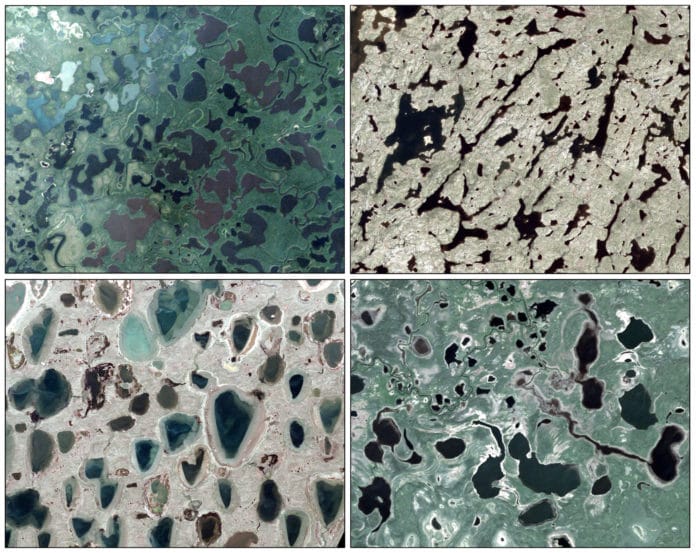Scientists at the Brown University used an army of small satellites and have shown that water levels in small lakes across northern Canada and Alaska are far more variable during the summer than previously thought. This discovery could pave a new way for scientists to gauge the greenhouse gas emissions from these northern lakes.
For the study, scientists used gathered the images from more than 150 Cubesats. The pictures empowered the scientists to perceive how the lakes changed after some time. They discovered little yet noteworthy shoreline changes in individual lakes that add up to many square kilometers of a lake region change over the examination locale.
The investigation region catches a significant swath of Arctic tundra and boreal forest, a biome that circles the Earth’s northern hemisphere of the equator in a band from around 50 to 70 degrees north scope. The region is home to critical forest and tundra biological communities just as the planet’s most elevated thickness of lakes, so understanding its hydrology is experimentally critical.
One explanation behind that will be that boreal lakes are a noteworthy wellspring of regular ozone-harming substance emanations. Their dregs contain huge amounts of organic carbon, which washes in from the encompassing scene. A portion of that carbon at that point decays and it produced into the air as carbon dioxide and methane ozone-harming substances.
Scientists noted, “This new finding of substantial summer shoreline fluctuation has implications for how scientists calculate these emissions. That’s because shoreline areas where water ebbs and flows from season to season are known hotspots for greenhouse gas production and emission. But estimates of lake emissions generally assume shorelines to be stable within each season. The finding of surprising within-season shoreline fluctuation, the researchers say, suggests that current emissions models from boreal lakes may be underestimated.”
Sarah Cooley, a Ph.D. student at Brown University and the study’s lead author said, “A shoreline that’s fluctuating is going to emit more carbon than a stable shoreline. These short-term fluctuations, which no one had ever mapped before, suggest these lakes are potentially emitting more gas than people thought.”
Laurence C. Smith, a co-author of the study and project leader for NASA’s Arctic-Boreal Vulnerability Experiment, which helped fund the study said, “Previous studies assumed lakes in this area to be relatively stable. To our surprise, the high-resolution, high-frequency imaging afforded by CubeSats revealed that small shoreline fluctuations in this lake-rich area sum to impressively large numbers.”
In all, the study explored four sub-areas of the North American Arctic and sub-Arctic and found the little-studied Canadian Shield to be most dynamic of all, with about 1.4 percent of its landscape seasonally inundated by small fluctuations in lake levels.
Cooley said, “What I’m most excited about from a science perspective is the ability to make use of this new CubeSat imagery,” Cooley said. “We couldn’t have made these observations without the CubeSats, and here we show that it’s possible to extract valuable scientific information from those images.”
Large space organization satellites trimmed with touchy logical instruments can assemble a wide range of data, however, basically, don’t make enough overhead goes to get changes that happen over brief timeframes. Furthermore, the satellites that do ignore once a day come up short on the camera goals to mention fine-scale objective facts of the ake region.
The CubeSats, as of late propelled by an organization called Planet, offered a potential solution. The organization works in excess of 150 satellites, which circle the Earth in a course of action that empowers them to picture Earth’s whole landmass every day as the planet pivots underneath them. And keeping in mind that the small satellites need modern logical hardware, they do have powerful cameras fit for catching pictures with 3-meter resolution.
So Cooley had to design her own system to compensate for those issues. For the study, she trained a machine learning algorithm to spot anomalous data patterns and throw them away. For example, instances in which a lake suddenly disappears in a day only to return to view a few days later are most likely due to cloud cover or glitchy observations, not an actual lake disappearance. The algorithm could flag such instances and remove them from the data.
Using that algorithm, Cooley and her colleagues were able to sift through more 25 terabytes of CubeSat data.
Cooley says she expects more interesting earth science findings from CubeSats in the coming years.
“I see this as a beginning of a new period in remote sensing, in that suddenly all sorts of earth observations that may not have been possible before will become possible with these small, simple satellites.”
The findings are published in Geophysical Research Letters.
